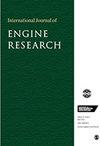电动辅助涡轮增压器中的排气门控制策略:学生方程式赛车案例研究
IF 2.1
4区 工程技术
Q2 ENGINEERING, MECHANICAL
引用次数: 0
摘要
对减少碳排放的追求推动了动力总成的创新,尤其是在汽车领域。本研究旨在对内燃机(ICE)上的电动辅助涡轮增压(eTurbo)进行数值分析,重点是优化不同发动机转速下的废气门控制。研究结果凸显了废气门设置对制动特定油耗(BSFC)、功率和扭矩等关键参数的重要影响。通过细致的模拟和验证,该研究确定了不同发动机转速下的最佳废气门配置。结果表明,精确控制对 BSFC、功率、扭矩和整体效率有着深远的影响。此外,研究结果还强调了电子涡轮增压性能的动态特性,强调了定制控制策略的重要性。自然吸气模型通过本田 CBR600RR 发动机的实际数据进行了验证,该发动机集成在学生方程式赛车的动力系统中,符合比赛规定。从底盘测功机获得的扭矩测量结果显示,最大相对误差为 8%。我们提出了一种动态控制策略,可根据发动机工况实时调整废气门,从而提高系统效率和性能,为提高发动机效率和可持续交通解决方案做出贡献。稳态模拟结果表明,废气门调节能显著改善性能,提高发动机制动功率、容积效率、发动机制动特定燃料消耗量(BSFC)和等效制动特定燃料消耗量(EBSFC)。EBSFC 会根据废气门配置和发动机转速发生细微变化。在涡轮增压器转速为 140,000 rpm 时,当废气门开度为 40%、发动机转速为 10,000 rpm 时,EBSFC 下降 2.8%;当废气门开度为 20%、发动机转速为 12,000 rpm 时,EBSFC 下降 2.5%。本文章由计算机程序翻译,如有差异,请以英文原文为准。
Wastegate control strategy in electrically assisted turbochargers: A formula student car case study
The pursuit of reduced carbon emissions has spurred powertrain innovations, especially in the automotive sector. This study aims to numerically analyze the electrically assisted turbocharging (eTurbo) on internal combustion engines (ICEs) with a specific focus on optimizing wastegate control across diverse engine speeds. Results highlight the significant influence of wastegate settings on critical parameters such as brake-specific fuel consumption (BSFC), power, and torque. Through meticulous simulations and validation, the study identifies optimal wastegate configurations for different engine speeds. Precision control is shown to have a profound impact on BSFC, power, torque, and overall efficiency. Additionally, findings underscore the dynamic nature of eTurbo performance, emphasizing the importance of customized control strategies. The naturally aspirated model is validated with real-world data from a Honda CBR600RR engine integrated into a Formula Student vehicle powertrain, meeting competition regulations. Torque measurements obtained from a chassis dynamometer reveal a maximum relative error of 8%. A dynamic control strategy is proposed to adapt wastegate adjustments in real-time based on engine conditions, aiming to enhance system efficiency and performance, contributing to improved engine efficiency and sustainable transportation solutions. The steady state simulation results demonstrate that wastegate adjustments significantly improve performance, enhancing engine brake power, volumetric efficiency, Engine Brake Specific Fuel Consumption (BSFC), and Equivalent Brake Specific Fuel Consumption (EBSFC). EBSFC exhibits nuanced changes based on wastegate configurations and engine speeds. At a turbocharger speed of 140,000 rpm, the EBSFC drops by 2.8% at 40% wastegate opening and 10,000 rpm engine speed, while it drops by 2.5% at 20% wastegate opening and 12,000 rpm.
求助全文
通过发布文献求助,成功后即可免费获取论文全文。
去求助
来源期刊

International Journal of Engine Research
工程技术-工程:机械
CiteScore
6.50
自引率
16.00%
发文量
130
审稿时长
>12 weeks
期刊介绍:
The International Journal of Engine Research publishes high quality papers on experimental and analytical studies of engine technology.
 求助内容:
求助内容: 应助结果提醒方式:
应助结果提醒方式:


